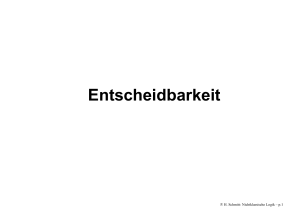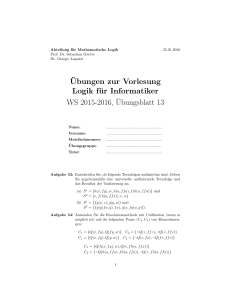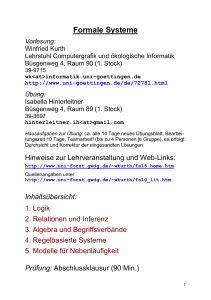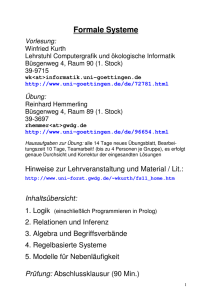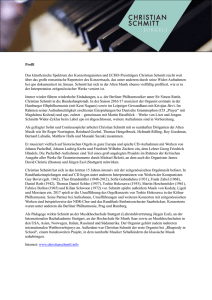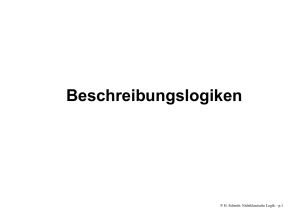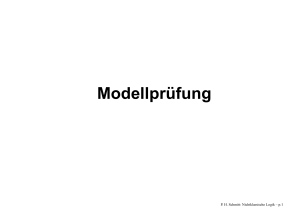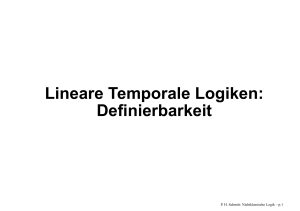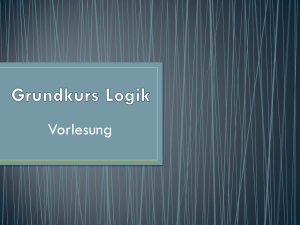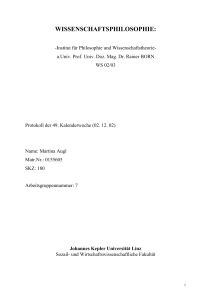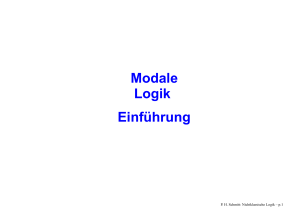Modale Logik Einführung - Logik und Formale Methoden
Werbung
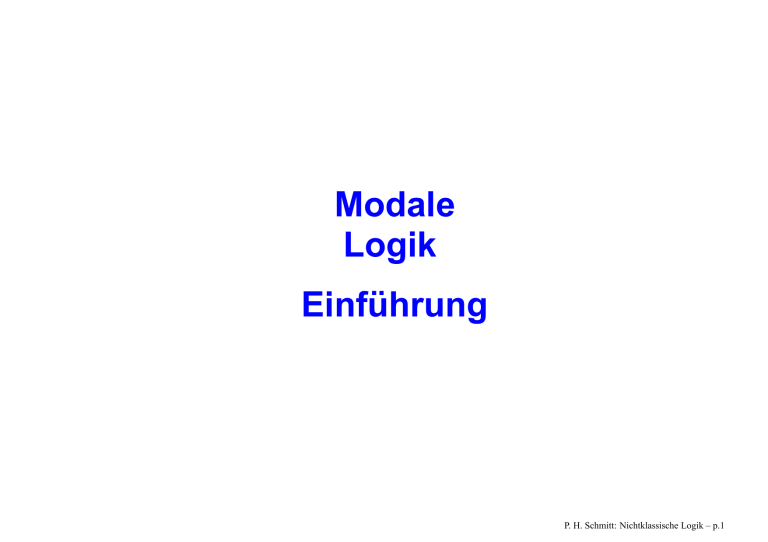
Modale
Logik
Einführung
P. H. Schmitt: Nichtklassische Logik – p.1
Modal Logic
In classical logic, it is only important whether a formula is true
In modal logic, it is also important in which
•
way
•
mode
•
state
a formula is true
P. H. Schmitt: Nichtklassische Logik – p.2
Modal Logic
In classical logic, it is only important whether a formula is true
In modal logic, it is also important in which
•
way
•
mode
•
state
a formula is true
A formula (a proposition) is
•
necessarily / possibly true
•
true today / tomorrow
•
believed / known
•
true before / after an action / the execution of a program
P. H. Schmitt: Nichtklassische Logik – p.2
Propositional Modal Logic: Formulas
•
The propositional variables are modal formulas
•
If A, B are modal formulas, then
¬A
2A
3A
(A ∧ B)
(A ∨ B)
(A → B)
(read “box A”, “necessarily A”)
(read “diamond A”, “possibly A”)
(A ↔ B)
are modal formulas
P. H. Schmitt: Nichtklassische Logik – p.3
Informal Interpretations of 2
2F means
•
F is necessarily true
•
F is always true (in future states/words)
•
an agent a believes F
•
an agent a knows F
•
F is true after all possible executions of a program p
P. H. Schmitt: Nichtklassische Logik – p.4
Informal Interpretations of 2
2F means
•
F is necessarily true
•
F is always true (in future states/words)
•
an agent a believes F
•
an agent a knows F
•
F is true after all possible executions of a program p
Notation
If necessary write
2a F
2pF
[a]F
[p]F
instead of 2F
P. H. Schmitt: Nichtklassische Logik – p.4
Informal Interpretations of 3
2F
F is necessarily true
F is always true
agent a believes F
agent a knows F
F is true after all possible
executions of program p
3F
(the same as ¬2¬F )
F is possibly true
F at least once true
F is consistent with a’s beliefs
a does not know ¬F
F is true after at least one possible
execution of program p
P. H. Schmitt: Nichtklassische Logik – p.5
Ein Puzzle
Drei Weisen werden Hüte aufgesetzt, jedem genau einer. Die Hüte
sind entweder weiß oder schwarz, und jedem ist bekannt, daß
mindestens ein schwarzer Hut mit dabei ist.
Jeder der Weisen sieht, welche Hüte die anderen beiden aufsitzen
haben und soll erschließen, welchen Hut er aufsitzen hat, natürlich
ohne in einen Spiegel zu schauen, den Hut abzunehmen oder
ähnliches.
Nach einer Weile sagt einer der Weisen: "Ich weiß nicht, welchen Hut
ich aufhabe.Nach einer weiteren Pause des Nachdenkens sagt ein
zweiter: "Ich weiß auch nicht, welchen Hut ich aufhabe."
"Dann", sagt der Dritte, "weiß ich, daß ich einen schwarzen Hut
aufhabe."
P. H. Schmitt: Nichtklassische Logik – p.6
Formalisierung des Puzzles
Notation
Si
der i-te Weise hat einen schwarzen Hut auf
Wi
der i-te Weise hat einen weißen Hut auf
2i A der i-te Weise weiß, daß A wahr ist
jeweils für i ∈ {1, 2, 3}.
P. H. Schmitt: Nichtklassische Logik – p.7
Formalisierung des Puzzles
Fakten
•
¬21 S1
(B1 )
P. H. Schmitt: Nichtklassische Logik – p.8
Formalisierung des Puzzles
Fakten
•
¬21 S1
•
¬22 S2
(B1 )
(B2 )
P. H. Schmitt: Nichtklassische Logik – p.8
Formalisierung des Puzzles
Fakten
•
¬21 S1
(B1 )
•
¬22 S2
(B2 )
•
Wi ∧W j → Sk
für i, j, k ∈ {1, 2, 3} paarweise verschieden
P. H. Schmitt: Nichtklassische Logik – p.8
Formalisierung des Puzzles
Fakten
•
¬21 S1
(B1 )
•
¬22 S2
(B2 )
•
Wi ∧W j → Sk
•
Wi → 2 jWi
für i, j, k ∈ {1, 2, 3} paarweise verschieden
für i, j ∈ {1, 2, 3}, i 6= j
P. H. Schmitt: Nichtklassische Logik – p.8
Formalisierung des Puzzles
Fakten
•
¬21 S1
(B1 )
•
¬22 S2
(B2 )
•
Wi ∧W j → Sk
•
Wi → 2 jWi
•
¬Wi → 2 j ¬Wi
für i, j, k ∈ {1, 2, 3} paarweise verschieden
für i, j ∈ {1, 2, 3}, i 6= j
für i, j ∈ {1, 2, 3}, i 6= j
P. H. Schmitt: Nichtklassische Logik – p.8
Formalisierung des Puzzles
Fakten
•
¬21 S1
(B1 )
•
¬22 S2
(B2 )
•
Wi ∧W j → Sk
•
Wi → 2 jWi
•
¬Wi → 2 j ¬Wi
•
¬Wi → Si
für i, j, k ∈ {1, 2, 3} paarweise verschieden
für i, j ∈ {1, 2, 3}, i 6= j
für i, j ∈ {1, 2, 3}, i 6= j
für i ∈ {1, 2, 3}
P. H. Schmitt: Nichtklassische Logik – p.8
Formalisierung des Puzzles
Fakten
•
¬21 S1
(B1 )
•
¬22 S2
(B2 )
•
Wi ∧W j → Sk
•
Wi → 2 jWi
•
¬Wi → 2 j ¬Wi
•
¬Wi → Si
für i ∈ {1, 2, 3}
•
¬Si → Wi
für i ∈ {1, 2, 3}
für i, j, k ∈ {1, 2, 3} paarweise verschieden
für i, j ∈ {1, 2, 3}, i 6= j
für i, j ∈ {1, 2, 3}, i 6= j
P. H. Schmitt: Nichtklassische Logik – p.8
Formalisierung des Puzzles
Fakten
•
¬21 S1
(B1 )
•
¬22 S2
(B2 )
•
Wi ∧W j → Sk
•
Wi → 2 jWi
•
¬Wi → 2 j ¬Wi
•
¬Wi → Si
für i ∈ {1, 2, 3}
•
¬Si → Wi
für i ∈ {1, 2, 3}
•
Si ∨Wi
für i, j, k ∈ {1, 2, 3} paarweise verschieden
für i, j ∈ {1, 2, 3}, i 6= j
für i, j ∈ {1, 2, 3}, i 6= j
für i ∈ {1, 2, 3}
P. H. Schmitt: Nichtklassische Logik – p.8
Akzeptable Axiome
•
alle AL-Axiome z.B. 21 A ∨ ¬21 A
P. H. Schmitt: Nichtklassische Logik – p.9
Akzeptable Axiome
•
alle AL-Axiome z.B. 21 A ∨ ¬21 A
•
(2A ∧ 2(A → B)) → 2B
(K)
P. H. Schmitt: Nichtklassische Logik – p.9
Akzeptable Axiome
•
alle AL-Axiome z.B. 21 A ∨ ¬21 A
•
(2A ∧ 2(A → B)) → 2B
•
2(A → B) → (2(A) → 2B
(K)
(K)
P. H. Schmitt: Nichtklassische Logik – p.9
Akzeptable Schlußregeln
•
A A→B
B
(Modus ponens)
Man beachte:
Die Regel (G) is nicht das gleiche, wie A → 2A als Axiom zu
verwenden.
P. H. Schmitt: Nichtklassische Logik – p.10
Akzeptable Schlußregeln
•
A A→B
B
•
A
2A
(Modus ponens)
(G)
Man beachte:
Die Regel (G) is nicht das gleiche, wie A → 2A als Axiom zu
verwenden.
P. H. Schmitt: Nichtklassische Logik – p.10
Modale Ableitbarkeit
Ein modallogisches System besteht aus Axiomen und Schlußregeln
Ein modallogische System S induziert eine Ableitbarkeitsrelation ` S .
Σ `S A
gilt für eine Formelmenge Σ ⊆ FmlALmod und eine Formel
A ∈ FmlALmod , wenn es einen Beweis für A gibt, der nur die Formeln
aus Σ und die Axiome und Schlußregeln von S benutzt.
P. H. Schmitt: Nichtklassische Logik – p.11
Das modallogische System K
Axiome
alle AL-Tautologien
(A → B) → (2(A) → 2B)
Regeln
A,A→B
B
A
2A
(K)
(MP)
(G)
P. H. Schmitt: Nichtklassische Logik – p.12
Einige modallogische Systeme
T
D
B
S4
S5
S4.2
S4.3
K
K
T
T
T
S4
S4
C
K
+
+
+
+
+
+
+
+
2(A) → A
2(A) → 3A
¬A → 2¬2A
2(A) → 22A
¬2(A) → 2¬2A
32(A) → 23A
2(2(A → B)) ∨ 2(2(B → A))
A→B
statt (G).
2(A → B)
P. H. Schmitt: Nichtklassische Logik – p.13
Kripke Frames and Kripke Structures
Definition
A Kripke frame
F = (S, R)
consists of
•
a non-empty set S
•
an accessibility relation R ⊆ S × S
(of worlds / states)
P. H. Schmitt: Nichtklassische Logik – p.14
Kripke Frames and Kripke Structures
Definition
A Kripke frame
F = (S, R)
consists of
•
a non-empty set S
•
an accessibility relation R ⊆ S × S
(of worlds / states)
Definition
A Kripke structure
K = (S, R, I)
consists of
F = (S, R)
•
a Kripke frame
•
an interpretation I : ALVar × S → {1, 0}
P. H. Schmitt: Nichtklassische Logik – p.14
Kripke Structures: Example
x2 p, q
p x1
x3 q
q x4
x5
x6 p
P. H. Schmitt: Nichtklassische Logik – p.15
Kripke Structures: Example
set of states
x2 p, q
p x1
x3 q
q x4
x5
x6 p
P. H. Schmitt: Nichtklassische Logik – p.15
Kripke Structures: Example
accessibility
relation
set of states
x2 p, q
p x1
x3 q
q x4
x5
x6 p
P. H. Schmitt: Nichtklassische Logik – p.15
Kripke Structures: Example
accessibility
relation
set of states
x2 p, q
p x1
x3 q
q x4
x5
x6 p
Interpretation I
P. H. Schmitt: Nichtklassische Logik – p.15
Modal Logic: Semantics
Given: Kripke structure K = (S, R, I)
Valuation
valK (p)(s) = I(p)(s)
for p ∈ ALVar
valK defined for propositional operators in the same way as in
classical logic
0
1 if valK (A)(s ) = 1 for
valK (2A)(s) =
all s0 ∈ S with sRs0
0 otherwise
0
if
val
(A)(s
) = 1 for
1
K
valK (3A)(s) =
at least one s0 ∈ S with sRs0
0 otherwise
P. H. Schmitt: Nichtklassische Logik – p.16
Modal Logic: Example for Evaluation
P A
¬P D
B ¬P
C P
P. H. Schmitt: Nichtklassische Logik – p.17
Modal Logic: Example for Evaluation
P A
¬P D
B ¬P
C P
(K , A) |= P
(K , B) |= ¬P
(K ,C) |= P
(K , D) |= ¬P
(K ,C) |= 2P
(K , D) |= 2P
(K , A) |= 2¬P (K , B) |= 2P
—
(K , A) |= 22P (K , B) |= 22P (K ,C) |= 22¬P
P. H. Schmitt: Nichtklassische Logik – p.17
Saul Aaron Kripke
Born 1940 in Omaha (US)
First
A Completeness Theorem in Modal Logic
publication:
The Journal of Symbolic Logic, 1959
Studied at:
Harvard, Princeton, Oxford
and Rockefeller University
Positions:
Harvard, Rockefeller, Columbia,
Cornell, Berkeley, UCLA, Oxford
since 1977
Professor at Princeton University
since 1998
Emeritus at Princeton University
P. H. Schmitt: Nichtklassische Logik – p.18
Konsequenzrelationen
Lokale modallogische Konsequenz
Sei Σ ⊆ FmlALmod und F ∈ FmlALmod .
Σ `L F
gilt genau dann, wenn für jede Kripke Struktur
K = (G, R, v) und jede Welt g ∈ G gilt:
falls g |= Σ , dann g |= F
P. H. Schmitt: Nichtklassische Logik – p.19
Konsequenzrelationen
Globale modallogische Konsequenz
Σ `G F
gilt genau dann, wenn für jede Kripke Struktur
K = (G, R, v):
falls für jede Welt g ∈ G gilt g |= Σ
dann
dann gilt auch für jede Welt g ∈ G
g |= F
P. H. Schmitt: Nichtklassische Logik – p.20
Relative Konsequenzrelationen
Sei T eine Klasse von Kripke Strukturen.
Relative lokale modallogische Konsequenz
Sei Σ ⊆ FmlALmod und F ∈ FmlALmod .
Σ `TL F
gilt genau dann, wenn für jede Kripke Struktur
K = (G, R, v) ∈ T und jede Welt g ∈ G gilt:
falls g |= Σ , dann g |= F
P. H. Schmitt: Nichtklassische Logik – p.21
Relative Konsequenzrelationen
Sei T eine Klasse von Kripke Strukturen.
Relative globale modallogische Konsequenz
Σ `TG F
gilt genau dann, wenn für jede Kripke Struktur
K = (G, R, v) ∈ T:
falls für jede Welt g ∈ G gilt g |= Σ
dann
dann gilt auch für jede Welt g ∈ G
g |= F
P. H. Schmitt: Nichtklassische Logik – p.22
Tautologie und Erfüllbarkeit
Eine Formel F heißt eine modallogische Tautologie oder
allgemeingültig, wenn 0/ ` F gilt.
Gilt für eine Klasse T von Kripke Strukturen 0/ `T F dann nennen wir
F eine T-Tautologie.
Eine Formelmenge Σ ⊆ FmlALmod heißt erfüllbar, wenn es eine
Kripke Stuktur K und eine Welt g gibt mit (K , g) ` Σ.
P. H. Schmitt: Nichtklassische Logik – p.23
Deduktionstheorem
Für A, B ∈ FmlALmod gilt
B `L A
gdw
gdw
{B, ¬A} ist nicht erfüllbar
`L B → A
P. H. Schmitt: Nichtklassische Logik – p.24
Deduktionstheorem
Für A, B ∈ FmlALmod gilt
B `L A
gdw
gdw
{B, ¬A} ist nicht erfüllbar
`L B → A
Beweis:
P. H. Schmitt: Nichtklassische Logik – p.24
Deduktionstheorem
Für A, B ∈ FmlALmod gilt
B `L A
gdw
gdw
{B, ¬A} ist nicht erfüllbar
`L B → A
Beweis:
Durch Einsetzen der Definitionen erhält man
B `L A
gdw
{B, ¬A} ist nicht erfüllbar
P. H. Schmitt: Nichtklassische Logik – p.24
Deduktionstheorem
Für A, B ∈ FmlALmod gilt
B `L A
gdw
gdw
{B, ¬A} ist nicht erfüllbar
`L B → A
Beweis:
Durch Einsetzen der Definitionen erhält man
B `L A
gdw
{B, ¬A} ist nicht erfüllbar
Rein aussagenlogisch ist die folgende Äquivalenz gültig:
{B → A} allgemeingültig
gdw
{B, ¬A} nicht erfüllbar
P. H. Schmitt: Nichtklassische Logik – p.24
Deduktionstheorem
Für A, B ∈ FmlALmod gilt
B `L A
gdw
gdw
{B, ¬A} ist nicht erfüllbar
`L B → A
Beweis:
Durch Einsetzen der Definitionen erhält man
B `L A
gdw
{B, ¬A} ist nicht erfüllbar
Rein aussagenlogisch ist die folgende Äquivalenz gültig:
{B → A} allgemeingültig
gdw
{B, ¬A} nicht erfüllbar
Wieder durch Einsetzen der Definitionen sieht man
{B → A} allgemeingültig
gdw
`L B → A
P. H. Schmitt: Nichtklassische Logik – p.24
Modal Logic: Valid Formulas
Valid
•
2(P → Q) → (2P → 2Q)
•
(2P ∧ 2(P → Q)) → 2Q
•
(2P ∨ 2Q) → 2(P ∨ Q)
•
(2P ∧ 2Q) ↔ 2(P ∧ Q)
•
2P ↔ ¬3¬P
•
3(P ∨ Q) ↔ (3P ∨ 3Q)
•
3(P ∧ Q) → (3P ∧ 3Q)
P. H. Schmitt: Nichtklassische Logik – p.25
Modal Logic: Valid Formulas
Valid
Not valid:
•
2(P → Q) → (2P → 2Q)
•
2(P ∨ Q) → (2P ∨ 2Q)
•
(2P ∧ 2(P → Q)) → 2Q
•
(3P ∧ 3Q) → 3(P ∧ Q)
•
(2P ∨ 2Q) → 2(P ∨ Q)
•
(2P ∧ 2Q) ↔ 2(P ∧ Q)
•
2P ↔ ¬3¬P
•
3(P ∨ Q) ↔ (3P ∨ 3Q)
•
3(P ∧ Q) → (3P ∧ 3Q)
P. H. Schmitt: Nichtklassische Logik – p.25
Not Valid: 2(P ∨ Q) → (2P ∨ 2Q)
s2 P, ¬Q
s1
s3 ¬P, Q
P. H. Schmitt: Nichtklassische Logik – p.26
Not Valid: 2(P ∨ Q) → (2P ∨ 2Q)
s2 P, ¬Q
s1
2(P ∨ Q)
s3 ¬P, Q
P. H. Schmitt: Nichtklassische Logik – p.26
Not Valid: 2(P ∨ Q) → (2P ∨ 2Q)
s2 P, ¬Q
s1
2(P ∨ Q)
¬2P
¬2Q
s3 ¬P, Q
P. H. Schmitt: Nichtklassische Logik – p.26
Not Valid: 2(P ∨ Q) → (2P ∨ 2Q)
s2 P, ¬Q
s1
2(P ∨ Q)
¬2P
¬2Q
¬(2P ∨ 2Q)
s3 ¬P, Q
P. H. Schmitt: Nichtklassische Logik – p.26
Not Valid: 2(P ∨ Q) → (2P ∨ 2Q)
s2 P, ¬Q
s1
2(P ∨ Q)
¬2P
¬2Q
¬(2P ∨ 2Q)
s3 ¬P, Q
2(P ∨ Q) → (2P ∨ 2Q) not true in state s1
P. H. Schmitt: Nichtklassische Logik – p.26
Eine formale Ableitung
W3 ∧W2 → S1
(1)
Faktum
P. H. Schmitt: Nichtklassische Logik – p.27
Eine formale Ableitung
W3 ∧W2 → S1
(1)
Faktum
21 (W3 ∧W2 → S1 )
(2)
aus (1) mit (G)
P. H. Schmitt: Nichtklassische Logik – p.27
Eine formale Ableitung
W3 ∧W2 → S1
(1)
Faktum
21 (W3 ∧W2 → S1 )
(2)
aus (1) mit (G)
21 (W3 ∧W2 → S1 ) ∧ ¬21 (S1 ) → ¬21 (W3 ∧W2 )
(3)
aus (K) und Aussagenlogik
P. H. Schmitt: Nichtklassische Logik – p.27
Eine formale Ableitung
W3 ∧W2 → S1
(1)
Faktum
21 (W3 ∧W2 → S1 )
(2)
aus (1) mit (G)
21 (W3 ∧W2 → S1 ) ∧ ¬21 (S1 ) → ¬21 (W3 ∧W2 )
(3)
aus (K) und Aussagenlogik
¬21 (W3 ∧W2 )
(4)
aus (2), (3) und Faktum B1 mit (MP)
P. H. Schmitt: Nichtklassische Logik – p.27
Eine formale Ableitung (Forts.)
(W3 → 21W3 ) ∧ (W2 → 21W2 )
(5)
Fakten
P. H. Schmitt: Nichtklassische Logik – p.28
Eine formale Ableitung (Forts.)
(W3 → 21W3 ) ∧ (W2 → 21W2 )
(5)
Fakten
W3 ∧W2 → 21W3 ∧ 21W2
(6)
mit AL aus (5)
P. H. Schmitt: Nichtklassische Logik – p.28
Eine formale Ableitung (Forts.)
(W3 → 21W3 ) ∧ (W2 → 21W2 )
(5)
Fakten
W3 ∧W2 → 21W3 ∧ 21W2
(6)
mit AL aus (5)
W3 ∧W2 → 21 (W3 ∧W2 )
(7)
mit (M), AL und (6)
P. H. Schmitt: Nichtklassische Logik – p.28
Eine formale Ableitung (Forts.)
(W3 → 21W3 ) ∧ (W2 → 21W2 )
(5)
Fakten
W3 ∧W2 → 21W3 ∧ 21W2
(6)
mit AL aus (5)
W3 ∧W2 → 21 (W3 ∧W2 )
(7)
mit (M), AL und (6)
¬(W3 ∧W2 )
(8)
mit AL aus (7) und (4)
P. H. Schmitt: Nichtklassische Logik – p.28
Eine formale Ableitung (Forts.)
22 (W3 → ¬W2 )
(9)
mit AL und Regel (G) aus (8)
P. H. Schmitt: Nichtklassische Logik – p.29
Eine formale Ableitung (Forts.)
22 (W3 → ¬W2 )
(9)
mit AL und Regel (G) aus (8)
22W3 → 22 ¬W2
(10)
mit Axiom (K) und AL aus (9)
P. H. Schmitt: Nichtklassische Logik – p.29
Eine formale Ableitung (Forts.)
22 (W3 → ¬W2 )
(9)
mit AL und Regel (G) aus (8)
22W3 → 22 ¬W2
(10)
mit Axiom (K) und AL aus (9)
¬22 ¬W2 → ¬22W3
(11)
Kontraposition von (10)
P. H. Schmitt: Nichtklassische Logik – p.29
Eine formale Ableitung (Forts.)
¬W2 → S2
(12)
Faktum
P. H. Schmitt: Nichtklassische Logik – p.30
Eine formale Ableitung (Forts.)
¬W2 → S2
(12)
Faktum
22 (¬W2 → S2 )
(13)
mit Regel (G) aus (12)
P. H. Schmitt: Nichtklassische Logik – p.30
Eine formale Ableitung (Forts.)
¬W2 → S2
(12)
Faktum
22 (¬W2 → S2 )
(13)
mit Regel (G) aus (12)
22 ¬W2 → 22 S2
(14)
mit (MP), Axiom (K) aus (13)
P. H. Schmitt: Nichtklassische Logik – p.30
Eine formale Ableitung (Forts.)
¬W2 → S2
(12)
Faktum
22 (¬W2 → S2 )
(13)
mit Regel (G) aus (12)
22 ¬W2 → 22 S2
(14)
mit (MP), Axiom (K) aus (13)
¬22 ¬W2
(15)
aus (14) mit AL und Faktum B2
P. H. Schmitt: Nichtklassische Logik – p.30
Eine formale Ableitung (Forts.)
¬W2 → S2
(12)
Faktum
22 (¬W2 → S2 )
(13)
mit Regel (G) aus (12)
22 ¬W2 → 22 S2
(14)
mit (MP), Axiom (K) aus (13)
¬22 ¬W2
(15)
aus (14) mit AL und Faktum B2
¬22W3
(16)
aus (15) und (11)
P. H. Schmitt: Nichtklassische Logik – p.30
Eine formale Ableitung (Forts.)
¬W3
(17)
aus (16), dem Faktum ¬W3 → 22 ¬W3 und AL
P. H. Schmitt: Nichtklassische Logik – p.31
Eine formale Ableitung (Forts.)
¬W3
(17)
aus (16), dem Faktum ¬W3 → 22 ¬W3 und AL
S3
(18)
aus (17) mit dem Faktum ¬W3 → S3
P. H. Schmitt: Nichtklassische Logik – p.31
Eine formale Ableitung (Forts.)
¬W3
(17)
aus (16), dem Faktum ¬W3 → 22 ¬W3 und AL
S3
(18)
aus (17) mit dem Faktum ¬W3 → S3
2 3 S3
(19)
mit Regel (G) aus (18)
P. H. Schmitt: Nichtklassische Logik – p.31
